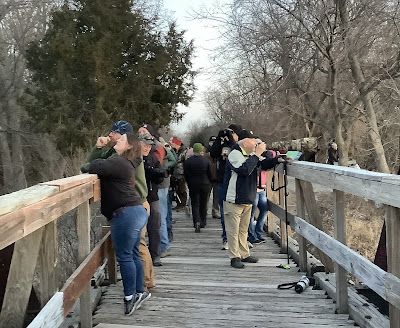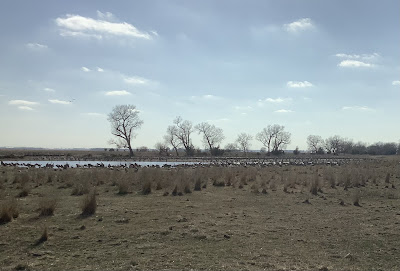Rather than the Cornhusker State, Nebraska could well be known as the Sand Hill Crane State, as more than a million, eighty per cent of the world’s population, congregate along the Platte River in the middle of the state each spring on their migration north to Alaska, Canada and Siberia. They hang out for several weeks feasting on stray corn kernels and worms and insects, gaining up to a pound each, fifteen per cent of their body weight, for their push north.
Their migration season in the one hundred mile stretch along the Platte is from Valentines Day to Tax Day. It peaks right about now. The Crane Trust aerial count was 450,000 cranes last week, but had inexplicably dipped to 375,000 this week, as their numbers usually exceed 600,000 at the peak.
I was unaware of the magnitude of this gathering until my friend Charlie, a fellow cyclist, proposed making a bicycle trip of it. Charlie had the urge to join the cycle touring fraternity, attempting a ride last summer to his 50th high school reunion in Evansville, but had to abort on day one when his tent poles slipped off the back of his bike. He proposed this as another attempt. I can never say no to a bicycle tour, and though I had plans to bike up the east coast in warmer temperatures from Orlando completing the slate of Carnegies in Florida, Georgia and the Carolinas, this would give me the opportunity to finish off Kansas, Missouri, Kentucky and West Virginia and almost Nebraska.
Eight of the eleven Carnegies in Nebraska I had yet to get to were strung along the southern border of the state and would be on the way to Kearney from Lincoln if we took the train to within 150 miles of the cranes. After much consideration we opted to drive, as Charlie needed to be home much earlier than me and scheduling a train back was tricky during the Easter/Spring Break season, particularly not knowing how many miles we’d be bicycling. It would give him great peace of mind knowing he had his car to get him home when we were done birding and biking.
The 650-mile drive was nothing for Charlie, as he has driven that distance up to the Boundary Waters to go canoeing at least once a year for the past thirty-five years and often twice a year in spring and fall. Those waters have such allure for him, he made the drive four times one year. With all that camping experience I knew I’d be traveling with an outdoorsman of the highest rank.
We whipped off the drive in ten hours, stopping just twice for gas and Charlie not once relinquishing the steering wheel, though it was a consideration, as before we left he asked, “I don’t mean to insult you, but do you drive?” It was high praise that he thought I was such a committed cyclist that I totally forsook the car.
The miles flew by as he told me stories of canoeing and his triplets and owning a battery store and and his days in the Toastmasters Club and elaborating on his eldest daughter, who spent three-and-half years traveling the world, extending her travels by working at hostels along the way, including a year in Australia. She and her partner, skydivers both, were visiting and sent us off. Her partner coaches the Quatari skydiving team and had just returned from a session with them. Meeting this fascinating pair was a great send-off.
When we came within fifty miles of Kearney on interstate 80 the sky began to fill with hundreds of cranes flying in formation and at a host of altitudes as if coordinated by some air traffic controller. There were hundreds more in the corn fields with heads bowed, pecking away. It seemed as if we had arrived in an alternate universe.
We resisted pulling over for photos as no one else was and we knew many more awaited us at the prime viewing spots, one of which was within Fort Kearney Recreational Area where we would be camping. Charlie had called ahead and was assured there’d be no problem camping, as few spots were taken with the temperature still hovering around freezing this time of year. The vast majority of those drawn to the birds stay in hotels.
We got the last of the three non-electric campsites. Not even a quarter of the more than hundred other campsites were occupied. Our neighbor was a couple from Denver who were back for a second year, better prepared this time with more warm clothes and lots of firewood. They gave us the lowdown on the best viewing spot and time. It was just a mile away on a former railroad bridge over the Platte that was now a paved bicycle path. Just before dark was when the birds came flying in and then just before light they departed en masse to their feeding grounds.
The bridge was lined with people when we arrived at 7:45, everyone bundled up and many shivering. The sky was filled all the way to the horizon with squadrons of birds in formation, though none were descending just yet. Most of the viewers had binoculars and many had long-lensed cameras. A guy with a mini-telescope on a tripod nudged me, noticing I didn’t have binoculars, and said, “You got to see this.” And he was right, the close-up was stunning. Later someone else offered me binoculars, reflecting the strong community spirit. Though there was a general hush, all the better to hear the symphonic cacophony in the sky above, there was an occasional gasp of “Wow” or “My god.”

After twenty minutes I needed to take a spin on my bike to warm up, as the windchill from a strong north wind had penetrated to the bone. I sprinted the three tenths of a mile back to the parking lot to circulate the blood. I scanned the license plates of the fifty plus cars. I didn’t see a one from east of the Mississippi, at least until the next day when two from Wisconsin and one from Maine showed up. Until then we thought we had come the furthest, except perhaps for one from Texas. There were a few Nebraska plates, but most were from nearby states—Colorado, Iowa, Kansas, Missouri and Wyoming.
The next day we made a forty-mile circuit of other viewing spots and a swing into Kearney, seven miles away on a premium asphalt bicycle path along interstate 80. Charlie ventured to the Walmart while I spent time in the library reading a few pages from a book on the Carnegie Libraries that I had missed when I snapped screenshots of it a year ago. Charlie bought up the store’s few remaining hand warmers as emergency backups to our sleeping bags, if only to warm cold feet, in case our bags failed to keep us warm in the predicted cold of the low twenties in the coming days. If there’d been more, we could have hawked them to the shivering bird-watchers, and paid for our trip.
We took a different route back from Kearney via Windmill State Recreational Area that turned into a dirt road for six miles. It was Charlie’s first “gravel” experience and he didn’t enjoy it in the least. It was barely a hiccup compared to the 1,200 miles of the unpaved Alaskan Highway I once rode, but I shared Charlie’s mystification that riding such roads is now a fad. After a few miles of pavement we had another does of dirt to an Audubon Society site along the Platte that was a combination gift shop and information center. We were told the one hundred places in its two evening viewing stands were booked until March 31 and it had some vacancies only due to a cancellation. They generally fill when they are made available the first of the year.

We had passed another viewing stand along the river, that a retired educator and naturalist, who’d been coming for the cranes from Cedar Rapids, Iowa for years, told us was comparable to the one we’d been at the night before. We were tempted to give it a try, but it would have required driving over. It had an added allure of talking with the educator’s wife, as she mentioned as we parted that she had ridden the third and fourth editions of RAGBRAI and then twice more, once with her mother and then with her husband shortly after they married. I would have liked to have heard about those experiences.
Curiously not so many birds came in from the west from the sunset, but were concentrated this evening in the east, adding all the more wonderment to this phenomenon. It would be tempting to see what the next night would bring, but the road beckoned, so we’d be seventy miles south closing in on the Carnegie in Superior near the Kansas border.







No comments:
Post a Comment